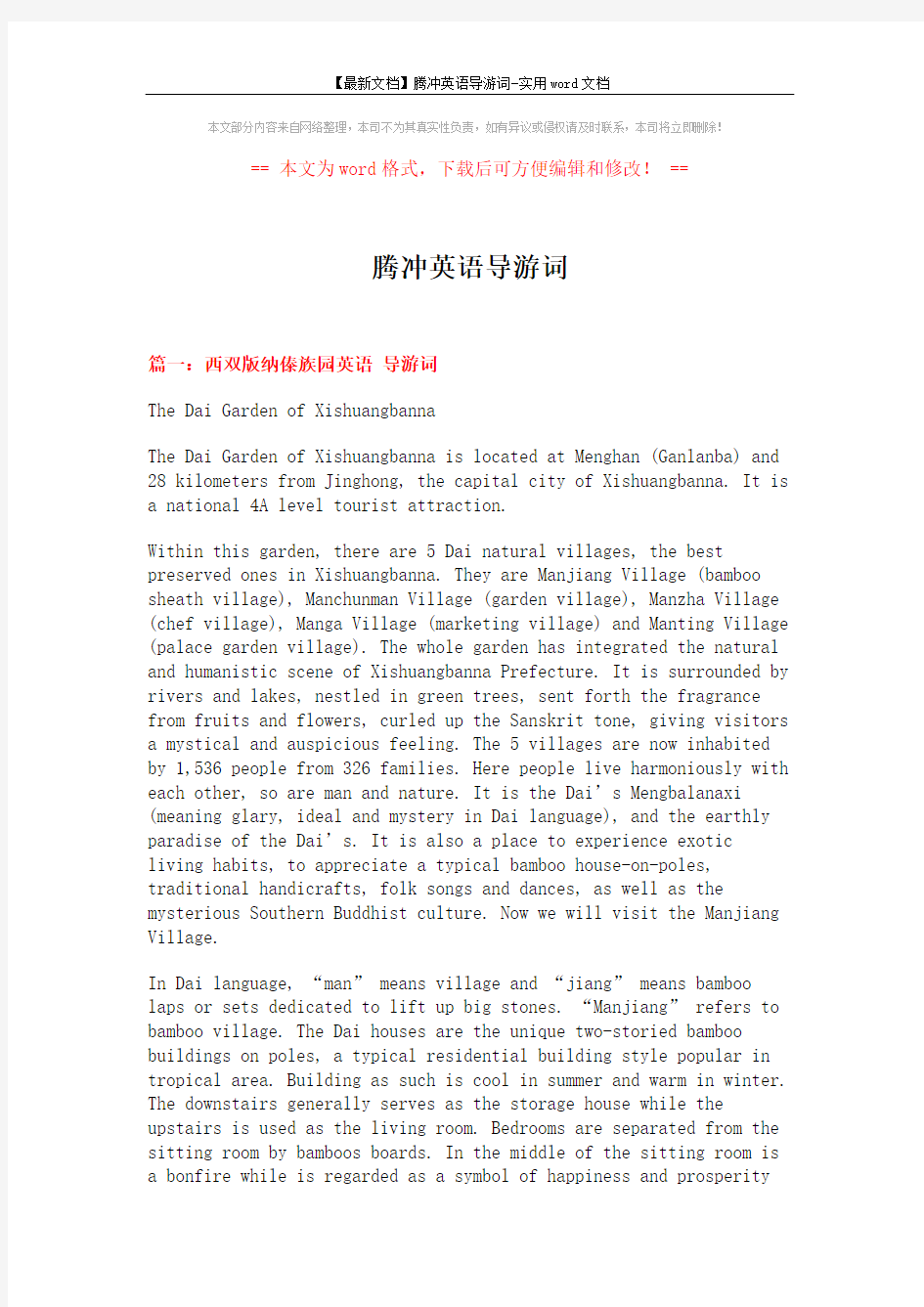【最新文档】腾冲英语导游词-实用word文档 (17页)


本文部分内容来自网络整理,本司不为其真实性负责,如有异议或侵权请及时联系,本司将立即删除!
== 本文为word格式,下载后可方便编辑和修改! ==
腾冲英语导游词
篇一:西双版纳傣族园英语导游词
The Dai Garden of Xishuangbanna
The Dai Garden of Xishuangbanna is located at Menghan (Ganlanba) and
28 kilometers from Jinghong, the capital city of Xishuangbanna. It is
a national 4A level tourist attraction.
Within this garden, there are 5 Dai natural villages, the best preserved ones in Xishuangbanna. They are Manjiang Village (bamboo sheath village), Manchunman Village (garden village), Manzha Village (chef village), Manga Village (marketing village) and Manting Village (palace garden village). The whole garden has integrated the natural and humanistic scene of Xishuangbanna Prefecture. It is surrounded by rivers and lakes, nestled in green trees, sent forth the fragrance from fruits and flowers, curled up the Sanskrit tone, giving visitors a mystical and auspicious feeling. The 5 villages are now inhabited by 1,536 people from 326 families. Here people live harmoniously with each other, so are man and nature. It is the Dai’s Mengbalanaxi (meaning glary, ideal and mystery in Dai language), and the earthly paradise of the Dai’s. It is also a place to experience exotic
living habits, to appreciate a typical bamboo house-on-poles, traditional handicrafts, folk songs and dances, as well as the mysterious Southern Buddhist culture. Now we will visit the Manjiang Village.
In Dai language, “man” means village and “jiang” means bamboo laps or se ts dedicated to lift up big stones. “Manjiang” refers to bamboo village. The Dai houses are the unique two-storied bamboo buildings on poles, a typical residential building style popular in tropical area. Building as such is cool in summer and warm in winter. The downstairs generally serves as the storage house while the upstairs is used as the living room. Bedrooms are separated from the sitting room by bamboos boards. In the middle of the sitting room is a bonfire while is regarded as a symbol of happiness and prosperity
of the whole family. For this reason, any striding over the bonfire
is impolite.
The whole family shares one bedroom, only separated by mosquito nets of different colors. Usually deep colored nets are used by the married, while white or light colored ones are used by the unmarried. Bedrooms are regarded as a mysterious place and no peering is allowed by strangers. Visitors to the family will be accommodated in the sitting room. Generally speaking, residential houses for Dai people are ventilated, pleasantly cool and wet-proof. They are also easy to build.The bamboo house is the dwelling place of the Dais while the Buddhist temple is a
habitat of the soul of the Dais. The Dais in Xishuangbanna worship Southern Buddhism, so where there is a village there is a Buddhist temple. There are taboos to be avoided when visiting a Buddhist temple. Visitors should shut their mouths so as not to make irresponsible remarks; Worshiping the Buddha definitely needs sincere desire, and then sincerity works miracles. On this there are several taboos: no touching on a monk’s head and cassock, no patting on the shoulder and body, no gesticulating in front of the image of the Buddha, no striking on the Buddhist drum, gong and other musical instruments of the temple.
Dai people are known to believe in southern Buddhism. Southern Buddhism believes that Sakyamuni is the patriarch or teacher, so the Buddha Statue in the temples is more human-like in size, figure and facial expression. And Southern Buddhism requires that a man be a monk for a period of time in his life in order to learn religious knowledge as well as cultural knowledge. For Dai people, Buddhist temple is not only a place for worshiping Buddha, but also a school for boys. The process of being monks is period for Dai boys to learn knowledge and experience their monkhood before the age 17.
Now we are going to the largest open air theatre of Yunnan tourist area--- Mengbalanaxi Theater. It is where visitors appreciate Dai songs and dance while having a rest. Some Dai folk dances includes peacock dance, candle-bar dance, long fingernail dance, fish dance, knife dance, stick dance and fist dance, which covey unique styles of the Dais. The well-known dancers Dao Meilan and Yang Liping are regarded as two golden peacocks flying out from Xishuangbanna. Also we can join in the Eastern Carnival —Water splashing Festival in the Dai Garden.
Water-Splashing Festival falls in mid April and lasts for three days. It is not only a traditional gala for Dai people but also a carnival
in the East. It is the New Year for Dai people. Dai people celebrate this festival with dragon boat races, throwing pouches (a bag (pouch)-throwing contest for finding a sweetheart) and shooting “gaosheng” (local firecracker). On the second day, the Dais often hold sand-piling and chicken-fighting activities while the third day
is a time for Dai people to express good wishes to each other. It is believed that the King of Dai arrives and the Dai people are sure to give the Buddha a bath and they get together, sprinkle water on each other for a blessing. Here people can s
plash water on their loved ones and close friends, washing away the worries and troubles. Young girls would gently sprinkle water on visitors from afar, wishing them good luck and happiness.
Dai people often say, “The more splashing water one gets, the luckie r he becomes”. Basins of sacred water would bring happiness
and make one forget all the worries. This activity and the cultural elements it contains impresses tourists from around the world.
篇二:云南导游口试腾冲和顺导游词
今天我们要去游览的地方就是被誉为“中国十大魅力名镇之首”,也是云南著
名的桥乡——和顺乡。
既然,能够获得“中国第一魅力名镇”的称号,呢么!和顺固然有它独特的魅力所在。位于腾冲县城以西3公里处的和顺乡,不仅拥有,深厚的历史文化,浓
郁的人文气息,在这儿,田园牧歌式的美丽风光可谓是,随处可见。而他的独
特之处在于,首先,他是面向南亚的第一镇,有着两千多年历史的,南方丝绸
之路,连接了中印两大文明古国,著名的史迪威公路穿越和顺。其次,和顺是
火山环抱的休闲胜地,是国家级风景名胜区。生活在这里的和顺人世代从大山
里出国闯荡,以大马帮为连接中印缅的主要交通工具,产生了一批,雄商巨贾,型成了亦商、亦桥、亦农、亦儒的独特生存方式。因此,这里也成为了汉文化
与南亚文化、西方文化交融的窗口。西方建筑、南亚建筑元素与云南“三房一
照壁、四合五天井”的古民居恰到好处的融为一体。而且,他还是南方丝绸之
路上最大的侨乡,至今和顺侨居海外的华人、华侨有一万余人,并形成了“海
外的和顺”。而居住在本乡的人口仅有6千多人,其中,归侨和侨眷占全乡人
口的80%,因此和顺成为云南著名的侨乡。所以大家不难看出,这里是六千居
民和谐生活的古镇,他展现的是令人向往的田园牧歌式的生活,是一个“活动
的古镇”。
现在呢!请各位往车窗外看,位于盆地中的乡镇就是和顺乡。小镇群山环抱,远远望去,全乡住宅从东到西,环山而建,连绵一二公里。说话间我们以到达目
的地。
走进和顺之前,我们第一眼看到的便是“和顺顺河”牌坊。牌坊的背面是我国
著名学者、曾任腾越道的赵藩,书写的“仁里”两个字,说明和顺是仁义道德
之乡。除了此之外,东边双虹桥头的“文治光昌”牌坊和西边双红桥头的贞节
牌坊。都可以看出和顺深受中国传统儒家文化的影响。各位请看,这是为纪念
和顺荣登“中国十大魅力名镇”,并夺取“中国魅力名镇展示201X年年度大奖”而树立的纪念碑。
踏进和顺的青石板路,便一脚踏进了百年的历史的光阴。据考古材料证实,明
代初期,经和顺人几个大姓的始祖以军职屯守此地,便开创了和顺新的历史。
大家请看在我们前方荷花池中的亭子它叫雨洲亭,是乡人为纪念首任和顺益群
中学校长,后任云南大学副校长的寸树声先生而建的,体现了和顺人尊师重教
的优良传统。亭中有原全国人大副委员长楚图南先生题写的亭名牌。看过雨洲
亭我们继续前行,在入村道路的中段,建有一座造型古朴的亭子,亭子四面有
门洞,亭内设有长凳,这便是公路人避雨、歇脚纳凉的风雨亭。在风雨亭的旁
边就是绕村而过的小河,在小河之上呢有两座石拱桥,因形如双虹,故名双虹桥。
在双虹桥的旁边就是全国最大的乡村图书馆——和顺图书馆。清朝末年,和顺
出现了传播新思想、新文化的进步团体“咸新社”,1924年和顺旅缅华侨又组
织“崇新会”,创办进步刊物,并在本乡成立“阅书报社”。1928年“阅书报社”扩建为图书馆,1938年新馆舍落成。是国家级重点文物保护单位和全国侨
联的爱国主义教育基地。和顺图书馆的大门居高临下,门上悬挂着黑底金字大匾——和顺图书馆,这是和顺清末举人张砺书写。二门上的“和顺图书馆”匾,由胡适
题写,“文化之津”匾是李石曾题写的。前面这栋半亭回廊式二层楼房,就是
图书馆的主楼,这是一栋两层上下五格的中西合璧式建筑,其中第一、四格伸
出呈六角亭。整个屋架轩敞,柱少梁多,四壁着色素雅,室内通明透亮。主楼
的后面是1998年落成的藏书楼,建筑为全钢混泥土仿古跨檐式二层楼房,该楼
的建成使图书馆的图书保管及容量得到进一步的提高。主楼后面的这幢洁白庄
严的仿古建筑叫“藏珍楼”,其中有全套《大藏经》、《升庵全集》数百册
“武英殿丛书”,近千册《四部丛书》,另外还有不少古籍善本、珍本,尤以
清代木刻版本为贵,听到这儿您是不是会忧心的叹一句,不愧“珍藏”啊!管内现有藏书7万余册,在中国乡村文化界堪称第一。坚实的文化根基,孕育出一
个个贤人英才。和顺乡名人极多,如同盟会员、辛亥革命元老们;曾任云南护国军第一秘书长李曰垓先生。云南大学副校长,名传滇中的教育家寸树声先生,
除此之外,还有我国著名的哲学家艾思奇也是腾冲和顺乡人。除此之外,在抗
战反攻腾冲期间,和顺图书馆曾是中国远征军第二十集团军司令部。
说话间我们来到了文昌宫,文昌宫不仅是和顺“文治光昌”的象征,而且还表
现了和顺人儒商并重的传统。文昌宫建于清代道光年间,历来就是教书育人的
地方,是和顺文化的摇篮,也是1940年由华侨捐资创办的益群中学旧址。现在,益群中学已改为公办,另觅校址,文昌宫便作为当地群众文化和健身活动场所。左右楼阁下镶嵌的“和顺两朝科甲提名碑”记录了和顺历史上出的8个举人、403个秀才的名字。文昌宫是和顺洞经会的活动基地。洞经音乐于清代乾隆年
